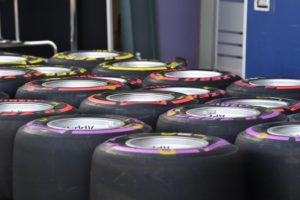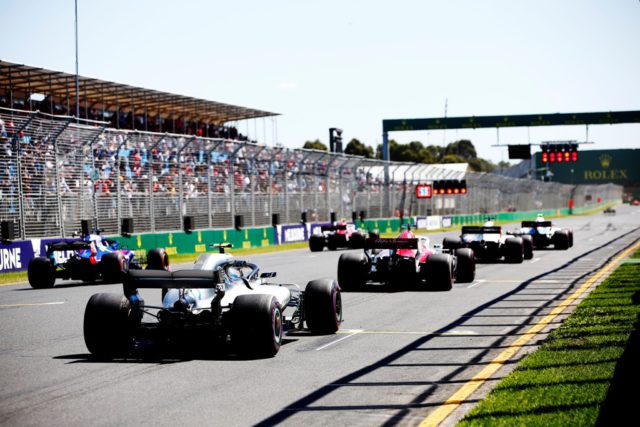For many of us, minimal changes in temperature will go unnoticed. In Formula One, however, small increases or decreases of even one or two degrees in temperature have a considerable impact on how teams approach a race or session.
With the upcoming Azerbaijan Grand prix shifting from the heat of June to its new spot on the calendar in the cooler climes of April, Mercedes is investigating what temperature changes mean for the teams.
The castle is calling! ?? #AzerbaijanGP pic.twitter.com/NjK96RjNog
— Red Bull Racing (@redbullracing) April 23, 2018
Two temperatures play an important role in F1: air temperature and track temperature
While the two are connected, they’re not the same. On a beautiful, sunny day, for example, both air and track temperatures will rise. As soon as cloud cover arrives, the air temperature will drop immediately. However, the track will retain the heat over a longer period of time and cool down slowly.
Depending on the surface materials, tracks might heat up faster or slower. If the track surface features a high level of bitumen, it will be darker – and thus absorb more sunlight and heat up quicker.
Variations in temperature impact many parts of the car, but the biggest influence is usually on the tyres. The track temperature impacts how hot the tyres will run. That which will, in turn, impact the grip level and the degradation rate.

F1 tyres have a very narrow operating window – the sweet spot being where they are at the peak of their performance in terms of grip levels
Operating below this window doesn’t produce the same levels of mechanical grip or performance while being above it can cause performance to drop and increase tyre wear. Missing the optimum tyre operating window by a few degrees can cost a tenth of a second in a lap time.
As the front and the rear tyres don’t operate at the same temperatures, a change in track temperature will impact them differently and increase or reduce their grip levels unevenly. Varying track temperatures will therefore also affect the balance of the car. So, teams will be regularly altering the car set-up to react to these changes.
But it’s not just the teams who react to those changes. It’s the drivers, too. Their driving style has an impact on tyre temperatures. Drivers will push harder if they want to put heat in the tyres, especially in high-speed corners.
If the track temperature changes considerably during a race, drivers have several ways to deal with this. In addition to how hard they push the tyres, they can alter their driving lines to suit the balance of the car, adjust the differential – the amount of torque transfer between the rear wheels – or the brake balance to the front or the rear of the car.
While the tyres are mostly impacted by the track temperature, the brakes, cooling and Power Unit are more heavily influenced by the air temperature
Therefore, teams are constantly monitoring both the air and track temperatures as well as the temperatures of the components within the cars themselves. This will allow them to see how those components are evolving and changing over the course of sessions or races.
Temperature swings will change the amount of cooling required to keep the Power Unit running in the optimum window, providing the teams with the best power output. If the ambient air is hot, more airflow is required to get it back to the optimum temperatures. So the teams will open up the bodywork in order to increase airflow through the radiators.
Teams may run different cooling configurations across a race weekend. That is in order to adapt to the expected conditions. This is especially true for race weekends such as Bahrain, where sessions take place in both hot daytime hours and the cooler temperatures of twilight.
It gets a little trickier when there is a large difference between conditions on Saturday and Sunday. The regulations don’t allow for changes to be made to cars between qualifying and the race.
It’s RACE WEEK ??
Baku, here we come!! ?#AzerbaijanGP ?? @FIA_F2 pic.twitter.com/txqhO5MthV
— George Russell (@GeorgeRussell63) April 23, 2018
Even without temperature variations, the set-up of the car on Saturday is always a balance between single lap performance and race competitiveness
The most aggressive set-up might produce great grip levels on a single lap in qualifying. But it also increases tyre wear in the race, so the teams have to find a compromise.
A forecasted temperature swing between Saturday and Sunday makes this process a bit more challenging. The teams have to keep Sunday’s conditions in mind as they prepare the car for qualifying on Saturday.

Alongside influencing parts of the car, temperature also has a physical impact on the drivers. They may be incredibly fit athletes and focus heavily on training, but driving F1 cars is a physically demanding task. Therefore, they can lose around one kilogram of bodyweight during races from fluid loss.
This figure increases with warmer temperatures, so the amount they drink is dependent on how warm or cool it is. Each driver has a drinks system in their car, with up to one litre of fluids being available to drink throughout the race.
Looking at the race weekend ahead, the new position on the calendar brings about an interesting challenge. The Azerbaijan GP moved from its late June spot on the calendar in late April. Because of that, the conditions of will be considerably different in comparison with last year. The difference in average temperatures from April to June in Baku can be around 10 degrees, which is a significant step when it comes to F1 cars.
When teams go to races with varying conditions, they’ll complete a sweep of simulations with different ambient and track temperatures in order to arm them with the set-up and cooling configuration changes required. Therefore, teams will be busy in the simulator ahead of F1’s return to Baku in order to understand how the changes in track temperature will influence the tyres and balance.
This helps the teams anticipate the necessary set-up changes
It’ s a crucial element of the pre-race preparations, allowing the teams to have a general understanding of how to set-up the car when they hit the track for real on Friday. They will then use the practice sessions to fine-tune the set-up and make sure the drivers are happy with the resultant car balance.
Of course, with Baku’s street track being one of the newest additions to the calendar, there isn’t as much historical data from past years to know what happens when conditions change. So, simulators are relied on more heavily in order to best prepare teams with the information and options when temperatures do vary.
He may be a rookie, but Sergey knows how tough Baku City Circuit is ?#F1 #AzerbaijanGP #F1Baku #StreetF1ghters pic.twitter.com/91KwJA12jf
— Baku City Circuit (@BakuCityCircuit) April 25, 2018

































